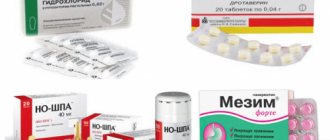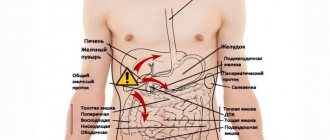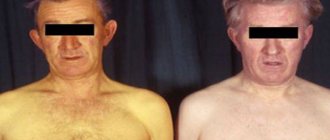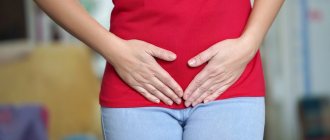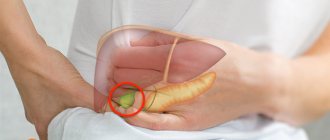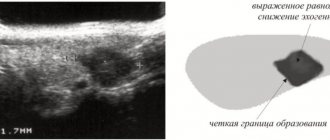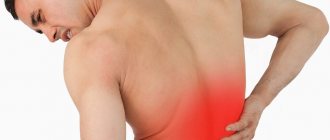Pain in the right side is a signal from the body about the development of serious processes that require outside participation. To correctly diagnose the disease, the doctor takes into account a number of indirect symptoms and the nature of the sensations, obtaining a holistic clinical picture.
What can hurt there?
This area of the upper quadrant of the abdomen contains the following vital organs: gallbladder, liver, right kidney, pancreas. The duodenum, small intestine, and diaphragm partially enter here. In view of such a wide list, it is obvious that the list of possible problems is also impressive.
Pain under the right rib is caused by the following body conditions:
- Cholecystitis associated with impaired patency of the biliary tract. Sudden discomfort usually occurs at night. Factors that provoke the disease include physiological disorders, stress, and nervous strain. A sharp painful spasm in the hypochondrium is caused by the movement of stones coming out of the gallbladder, which get stuck in the excretory duct, activating inflammation.
- Damage to the duodenum in the form of ulcerative duodenitis. The sensations in this case are stabbing, which is caused by the development of a pathological process on the mucous membrane of the digestive organ. At night, cramps can be acute and unbearable due to the lack of food in the stomach that requires digestion.
- Renal colic. It is not possible to get rid of such pain even by changing body position. Any movements only aggravate the condition. The cause of discomfort is stones moving through the urinary system.
- Pancreatitis. The disease is characterized by a feeling of intense painful pulsation on the right under the ribs due to inflammation of the pancreas.
Due to the similarity of symptoms of pathologies of various organs, you need to be able to classify unpleasant sensations according to their projection, as well as their nature.
In the picture you can see the location of the internal organs of a person
Causes of pain in the right hypochondrium
Dysfunction of the sphincter of Oddi of the biliary type
For this condition, the name “biliary dyskinesia” or “biliary dyskinesia (BDT)” was previously used. The sphincter of Oddi is a muscular valve that regulates the flow of bile into the duodenum. Its spasm can manifest itself as paroxysmal, less often constant, bursting or stabbing pain in the area of the right hypochondrium.
Pain in the right hypochondrium in front is provoked by physical activity, stress, sometimes associated with eating and in this case develops 2-3 hours after eating. The attack goes away on its own or after taking an antispasmodic drug; the condition improves with the use of a heating pad. Dyspepsia symptoms may also be observed - nausea and heaviness in the pit of the stomach.
Cholelithiasis
Failure to comply with the diet, a sedentary lifestyle and impaired cholesterol metabolism lead to stagnation of bile in the gallbladder with the formation of a “suspension”. Over time, layers build up on small suspended elements and concretions (stones) form. The presence of stones may not bother a person for a long time and becomes a finding during an ultrasound of the abdominal organs for another reason. This condition is called asymptomatic stone carriers.
pain on the right under the ribs
After intense physical activity, drinking large amounts of liquid or choleretic drugs, or experiencing “shaking” (for example, driving on a bad road), the stones may begin to move. Their movement in the gallbladder or movement along the biliary tract causes damage to the walls of the ducts, their reactive spasm and paroxysmal radiating pain in the right hypochondrium . The condition improves while taking antispasmodics or using a heating pad. Features of the nervous regulation of the biliary tract zone sometimes lead to reflex disturbances in heart rhythm (tachycardia, arrhythmia) or the appearance of referred pain in the right scapula, shoulder, collarbone, lower back, and heart region.
When the bile duct is completely blocked by a stone, “mechanical” jaundice develops, in which the flow of bile into the lumen of the duodenum stops, bile pigments enter the blood, causing the sclera and skin to turn yellow, itchy skin, feces become discolored, and urine becomes dark brown . This condition does not go away on its own and requires treatment in a hospital.
Hepatic colic
A severe attack of pain on the right under the ribs due to cholelithiasis is called hepatic colic. An attack of hepatic colic is a sharp, cramping pain in the right hypochondrium, which is accompanied by nausea, vomiting, flatulence, and pale skin. A person develops a cold sweat, a rapid heartbeat, and a decrease in blood pressure. He takes a forced position on his side with his legs pulled up or tosses around in bed and cannot find a position that would alleviate his condition.
Hepatic colic is an emergency condition and an indication for calling an ambulance. After injection of antispasmodic drugs and painkillers, the condition may improve. If there is no effect, hospitalization in a specialized surgical hospital is necessary. After hepatic colic, sometimes there remains sensitivity in the right hypochondrium, which is detected by palpation.
pain in the right hypochondrium
Acute cholecystitis
Inflammation of the gallbladder is manifested by severe constant pain in the area of the costal arch on the right with an increase in body temperature. There is a sharp increase in pain on palpation, nausea, repeated vomiting, symptoms of intoxication, and stool disorders.
In the absence of timely treatment, inflammation can turn into a purulent (destructive) form. In this case, the wall of the gallbladder melts, the nerve endings are destroyed and the pain syndrome decreases. The inflammatory contents pour into the peritoneal cavity or corrode the walls of neighboring organs, leading to the spread of the process and peritonitis. If you do not seek help from a medical facility, this condition can be fatal.
Chronic acalculous cholecystitis
Chronic inflammation of the gallbladder in the absence of stones is most often associated with a bacterial infection. With this disease, there is a dull aching pain, sometimes burning, the occurrence and intensity of which is directly related to errors in the diet (consumption of fatty, fried, smoked, spicy foods, alcohol).
Dyspepsia (nausea, heaviness in the pit of the stomach) is also a concern. With an exacerbation, the symptoms intensify, and the temperature may rise. During non-exacerbation periods, a feeling of discomfort in the right hypochondrium persists.
Postoperative changes
If during surgery to remove the gallbladder some manipulations were performed on the ducts, in the postoperative period they can lead to disruption of biliary function. Accidental damage to the peritoneum with instruments during surgery provokes the formation of adhesions between the internal organs. Such changes are manifested by nonspecific periodic pain in the right hypochondrium, often associated with food intake, when bile is secreted or intestinal peristalsis causes tension in the adhesions.
Cholangitis
Cholangitis is an inflammation of the bile ducts. Impaired excretion of bile, which develops in the case of cholangitis, is manifested by unpleasant sensations and heaviness under the costal arch on the right, increased temperature, stool disorders and symptoms of accumulation of pigments in the blood - itching of the skin, yellow discoloration of the sclera and skin.
Hepatitis
Hepatitis due to its development is divided into:
- infectious (occurs when infected with hepatitis viruses A, B, C, D, E and other microorganisms);
- medicinal (occurs as a side effect of the drug or the result of its overdose);
- autoimmune;
- toxic (with deliberate or accidental poisoning with hepatotropic substances, consumption of excessive amounts of alcohol).
According to duration, acute and chronic hepatitis are distinguished.
A diffuse inflammatory process in the liver leads to a disruption of its main functions - protein synthesis and the detoxification process, difficulty in excreting bile, as well as swelling of the liver tissue, an increase in the size of the organ and stretching of its capsule.
These changes are manifested by increased bleeding, hormonal imbalance and encephalopathy, including impaired consciousness. In addition, a person is worried about constant dull arching pain in the right hypochondrium, yellowing of the sclera and skin, general intoxication, weakness, and fever. The timing of the onset of symptoms and their intensity depend on the specific cause of hepatitis and its duration.
Cirrhosis of the liver
Replacement of liver cells with areas of connective tissue, which is characteristic of cirrhosis, rarely causes severe pain. More often the disease occurs hidden. In addition to discomfort and pain in the right hypochondrium, there is an increase in the volume of the abdomen, a stagnant blush appears on the cheeks, spider veins appear on the skin of the face and extremities, and hemorrhoidal nodes enlarge. In severe cases, varicose veins of the esophagus become dilated, which can become damaged during eating, leading to difficult-to-control bleeding.
Liver tumor
Since the nerve endings are located only in the liver capsule, pain and symptoms of compression of surrounding tissues appear only when the tumor grows into the organ capsule. The main symptoms of liver cancer are weight loss and dyspepsia.
Heart failure
In chronic heart failure, the pumping function of the heart is impaired. In this case, blood from the systemic circulation is not completely pumped into the small circle, and stagnation occurs in the afferent veins. Next, according to the domino principle, blood stagnation occurs in the liver (due to which the capsule is stretched and a bursting dull pain appears in the right side), then in the veins of the lower extremities, which leads to the development of swelling in the afternoon.
Blood diseases
Constant dull arching pain is observed with liver enlargement (hepatomegaly) against the background of acute leukemia or hemolytic anemia. In this case, there are accompanying severe symptoms that come to the fore:
- bleeding;
- tendency to frequent infectious diseases;
- pallor of the skin and mucous membranes;
- severe weakness and decreased performance.
Colon diseases
The flexure of the large intestine is located in the subhepatic region, so diseases of this part of the intestine (for example, chronic colitis, Crohn's disease, ulcerative colitis) can manifest as acute cramping pain in the right side. The presence of additional symptoms of the disease allows you to suspect intestinal pathology: abnormal stool, flatulence, the presence of mucus or blood in the stool.
Referred pain
Pain in the right hypochondrium is sometimes a symptom of a disease of an organ that is not located in this area. Such cases include appendicitis with an atypical location of the appendix and gynecological diseases: adnexitis, ovarian apoplexy, ectopic pregnancy.
Rare causes
Rare causes of pain in the right side include parasitic infestations (echinococcosis, ascariasis), liver injury (subcapsular hematoma or capsule tear), tumor of the gallbladder or bile ducts, cholestasis of pregnancy, liver infarction or abscess, storage diseases, tumor of the head of the pancreas , lower lobe pneumonia with pleurisy.
Pain in front
In such situations, doctors pay primary attention to the organs that are directly adjacent to the peritoneal wall.
Gallbladder
The diagnosis for such a symptom is an acutely developing inflammatory process. Cutting spasms are localized in the area of the abdominal muscle and are caused by the formation of crystalline formations in the ducts or neck or by the activity of bacterial microflora.
Such pain under the ribs in the front can radiate to the shoulder, accompanied by vomiting of green bile masses, nausea, belching, and bitterness in the mouth. With cholecystitis, bloating, picky eating, and yellowing of the whites of the eyes are associated.
Liver
It also becomes painful in the front hypochondrium as a result of structural deformations of a vital organ, when the death of cells is accompanied by the formation of nodes that compress the vessels and bile ducts. Unpleasant sensations are constant. This condition is observed in cirrhosis and hepatocellular carcinoma.
Compression of the capillaries and pain on the side are also possible with the formation of fluid-filled cystic structures. The reason is the entry of the helminthic parasite Echinococcus into the body.
Digestive tract
The problem may lie in the pathology of the colon, inflammation, including the development of granulomatous processes, when tissue necrosis is observed. Pain accompanying cancerous tumors can also project to the right upper quadrant of the abdomen.
Another option is the presence of gastritis, in which any deviation from the diet, even if eating homemade food, is fraught with a worsening of the condition.
The cardiovascular system
Unpleasant sensations at the top under the ribs are caused by impaired blood circulation in a closed area and subsequent edematous processes, the phenomena of VSD. In addition to heart failure, a pressure spasm, but with a burning sensation, provokes myocardial infarction.
The listed causes of pain are complemented by another option - the development of a pathological process in the appendix.
Treatment
The main principle of treating pain in the right hypochondrium is treatment of the underlying disease and the use of symptomatic painkillers.
Basic treatment methods:
- diet (excluding fatty, salty, fried, carbonated foods, alcohol);
- sufficient physical activity and control of water balance;
- taking antispasmodics for paroxysmal pain;
- taking painkillers, cholekinetics, choleretics, antibiotics, interferons, hepatoprotectors, conducting detoxification therapy as prescribed by a doctor;
- surgical treatment of cholelithiasis and acute cholecystitis - distance or contact lithotripsy (removal of stones), cholecystectomy (removal of the gallbladder);
- specific therapy for rare diseases.
Pain under the ribs at the back
A similar symptom accompanies pathologies of the adrenal gland, greater vena cava, intercostal neuralgia and mechanical injuries of the bone apparatus. Doctors include the following in the list of possible diseases:
- Pyelonephritis associated with the development of an acute infectious inflammatory process, carbuncle or abscess in the kidney.
- Damage caused by dislodged stones or sand in the ureteral cavity. In such a situation, pain may occur not only in the back, but also in the side.
- Infarction of the renal papillae or papillary necrosis. Severe discomfort persists constantly, and the development of septic shock is possible.
- Inflammatory processes in fatty tissue. Unpleasant sensations intensify with deep breathing and active movements.
- Osteochondrosis of the spinal region.
- Tumors of the adrenal gland, the formation of malignant formations that disrupt the outflow of urine. The lower back may ache constantly; sometimes it is possible to reduce the intensity of the pain by bending the torso.
When your right side hurts
The following options are possible here:
- If cramps are accompanied by nausea, acute or chronic pancreatitis with inflammation of the head of the pancreas should be considered. Sometimes not only the right side hurts, but also the back. Additional symptoms are general weakness and indigestion.
- Inflammation of the liver. The sensations are dull and are accompanied by pallor, yellowing of the skin, dyspepsia, and loss of appetite.
- Duodenitis. Unpleasant pulling sensations spread simultaneously to the back and shoulder blade.
For people susceptible to pain, spasms are not limited to the side only, so a feeling of discomfort in the upper right shoulder is possible.
Diagnostics
Primary diagnosis of diseases is carried out by a general practitioner - internist or family doctor. If pathology of the liver and bile ducts is detected, treatment can be carried out by a gastroenterologist, hepatologist or infectious disease specialist. Other conditions are observed by specialized specialists (cardiologist, oncologist, hematologist, etc.).
When diagnosing diseases that cause pain in the right hypochondrium, instrumental studies may be prescribed:
- Ultrasound of the abdominal organs;
- duodenal intubation with bile sampling;
- cholangiopancreatography to assess the patency of the bile ducts;
- CT scan of the abdominal cavity;
- liver elastography to determine the degree of cirrhosis;
- biopsy and others.
Laboratory examinations are also carried out:
- general blood test, biochemical analysis, coagulogram, lipidogram;
- markers of viral hepatitis,
- detection of parasite particles in biological material;
- tumor markers;
- autoimmune panel;
- FibroTest and others.
Nature of pain
In addition to the above classification of spasms in the hypochondrium, you need to remember some nuances associated with the type of discomfort that arises. This indicator is often decisive for making the correct diagnosis.
Pressure and heaviness in the side
A similar symptom often accompanies the late stages of pregnancy, when the grown-up baby is already too cramped in the stomach and any movement of the arm or leg, active upheavals cause the woman significant discomfort.
Pressure under the ribs from the side may also occur due to the following conditions:
- Thoracic osteochondrosis, in which it is painful to move, breathe and move your arms.
- Pathologies of the liver, gall bladder, urinary system. Diseases can be suspected by the addition of vomiting and nausea to the pain. Patients with such diseases tend to lie down more, since any movement, including walking and just a strong sigh, provokes an increase in spasm.
Stitching pain
People often complain about it after a long run. To exclude the cause in the form of stretching of the liver capsule against the background of dysfunction of the diaphragm and low blood outflow, it is important for both women and men to plan the load only after a preliminary warm-up.
The following tips will help you avoid tingling:
- Inhalation is always done through the nose. It is important that it be deep.
- Exhale through the mouth and only smoothly.
- While running, breathe exclusively from the stomach.
Stitching in the side above the center of the peritoneum can also occur with right-sided pneumonia. Lung damage is accompanied by shortness of breath, dyspepsia, increased temperature and blue discoloration of the tissues that form the nasolabial triangle.
Video: What can sting in the right side under the ribs
Blunt pain
Smoothed but persistent unpleasant sensations are characteristic of a number of chronic pathologies:
- Cholecystitis. Increased spasm occurs after eating fatty foods. Additional signs are vomiting, bloating. As the disease progresses, ulcers form on the thickened walls of the gallbladder, which scar over time.
- Pancreatitis. As a result of the replacement of the correct anatomical structure with connective tissue, the production of enzymes and the hormone insulin is disrupted. A dull pain may be present on both the right and left under the ribs. It is complemented by signs of dyspepsia: belching, bloating, diarrhea, nausea, heartburn, vomiting.
- Pyelonephritis. With inflammation in the pyelocaliceal system, the spasm may spread to the opposite side and intensify during physical activity. Additional signs: unreasonable increase in temperature and chills, increased urine flow, increased blood pressure, migraines, chronic fatigue.
- Hepatitis. The causes of discomfort that does not go away over time are improper treatment and lack of healing effect. The disease is accompanied by decreased appetite, regular nausea, flatulence, intolerance to fatty foods and alcohol. When palpating the hypochondrium and pressing on the liver, a characteristic aching spasm occurs.
- Duodenitis. The pain on the right side is accompanied by heartburn, poor appetite, regular diarrhea, and vomiting with bile.
